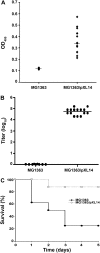Defense from the Group A Streptococcus by active and passive vaccination with the streptococcal hemoprotein receptor
- PMID: 21592989
- PMCID: PMC3096790
- DOI: 10.1093/infdis/jir149
Defense from the Group A Streptococcus by active and passive vaccination with the streptococcal hemoprotein receptor
Abstract
Background: The worldwide burden of the Group A Streptococcus (GAS) primary infection and sequelae is considerable, although immunization programs with broad coverage of the hyper variable GAS are still missing. We evaluate the streptococcal hemoprotein receptor (Shr), a conserved streptococcal protein, as a vaccine candidate against GAS infection.
Methods: Mice were immunized intraperitoneally with purified Shr or intranasally with Shr-expressing Lactococcus lactis. The resulting humoral response in serum and secretions was determined. We evaluated protection from GAS infection in mice after active or passive vaccination with Shr, and Shr antiserum was tested for bactericidal activity.
Results: A robust Shr-specific immunoglobulin (Ig) G response was observed in mouse serum after intraperitoneal vaccination with Shr. Intranasal immunization elicited both a strong IgG reaction in the serum and a specific IgA reaction in secretions. Shr immunization in both models allowed enhanced protection from systemic GAS challenge. Rabbit Shr antiserum was opsonizing, and mice that were administrated with Shr antiserum prior to the infection demonstrated a significantly higher survival rate than did mice treated with normal rabbit serum.
Conclusions: Shr is a promising vaccine candidate that is capable of eliciting bactericidal antibody response and conferring immunity against systemic GAS infection in both passive and active vaccination models.
Figures





Similar articles
-
Clinical and microbiological response of mice to intranasal inoculation with Lactococcus lactis expressing Group A Streptococcus antigens, to be used as an anti-streptococcal vaccine.Microbiol Immunol. 2018 Nov;62(11):711-719. doi: 10.1111/1348-0421.12657. Microbiol Immunol. 2018. PMID: 30357922
-
Protective immunity induced by an intranasal multivalent vaccine comprising 10 Lactococcus lactis strains expressing highly prevalent M-protein antigens derived from Group A Streptococcus.Microbiol Immunol. 2018 Jun;62(6):395-404. doi: 10.1111/1348-0421.12595. Epub 2018 Jun 11. Microbiol Immunol. 2018. PMID: 29704396 Free PMC article.
-
A novel live vector group A streptococcal emm type 9 vaccine delivered intranasally protects mice against challenge infection with emm type 9 group A streptococci.Clin Vaccine Immunol. 2014 Sep;21(9):1343-9. doi: 10.1128/CVI.00330-14. Epub 2014 Jul 23. Clin Vaccine Immunol. 2014. PMID: 25056362 Free PMC article.
-
Moving forward: a mucosal vaccine against group A streptococcus.Expert Rev Vaccines. 2009 Jun;8(6):747-60. doi: 10.1586/erv.09.33. Expert Rev Vaccines. 2009. PMID: 19485755 Review.
-
The Streptococcus pyogenes proteome: maps, virulence factors and vaccine candidates.Future Microbiol. 2010 Oct;5(10):1539-51. doi: 10.2217/fmb.10.116. Future Microbiol. 2010. PMID: 21073313 Free PMC article. Review.
Cited by
-
Antigen targeting to major histocompatibility complex class II with streptococcal mitogenic exotoxin Z-2 M1, a superantigen-based vaccine carrier.Clin Vaccine Immunol. 2012 Apr;19(4):574-86. doi: 10.1128/CVI.05446-11. Epub 2012 Feb 1. Clin Vaccine Immunol. 2012. PMID: 22301693 Free PMC article.
-
Study of streptococcal hemoprotein receptor (Shr) in iron acquisition and virulence of M1T1 group A streptococcus.Virulence. 2012 Nov 15;3(7):566-75. doi: 10.4161/viru.21933. Epub 2012 Oct 17. Virulence. 2012. PMID: 23076332 Free PMC article.
-
The Shr receptor from Streptococcus pyogenes uses a cap and release mechanism to acquire heme-iron from human hemoglobin.Proc Natl Acad Sci U S A. 2023 Jan 31;120(5):e2211939120. doi: 10.1073/pnas.2211939120. Epub 2023 Jan 24. Proc Natl Acad Sci U S A. 2023. PMID: 36693107 Free PMC article.
-
Modeling Streptococcus pyogenes Pharyngeal Colonization in the Mouse.Front Cell Infect Microbiol. 2019 May 2;9:137. doi: 10.3389/fcimb.2019.00137. eCollection 2019. Front Cell Infect Microbiol. 2019. PMID: 31119108 Free PMC article. Review.
-
Native Human Antibody to Shr Promotes Mice Survival After Intraperitoneal Challenge With Invasive Group A Streptococcus.J Infect Dis. 2021 Apr 23;223(8):1367-1375. doi: 10.1093/infdis/jiaa540. J Infect Dis. 2021. PMID: 32845315 Free PMC article.
References
-
- Steer AC, Danchin MH, Carapetis JR. Group A streptococcal infections in children. J Paediatr Child Health. 2007;43:203–13. - PubMed
-
- Guilherme L, Fae K, Oshiro SE, Kalil J. Molecular pathogenesis of rheumatic fever and rheumatic heart disease. Expert Rev Mol Med. 2005;7:1–15. - PubMed
-
- Guilherme L, Ramasawmy R, Kalil J. Rheumatic fever and rheumatic heart disease: genetics and pathogenesis. Scand J Immunol. 2007;66:199–207. - PubMed
-
- Snider LA, Swedo SE. Post-streptococcal autoimmune disorders of the central nervous system. Curr Opin Neurol. 2003;16:359–65. - PubMed
Publication types
MeSH terms
Substances
Grants and funding
LinkOut - more resources
Full Text Sources
Miscellaneous

